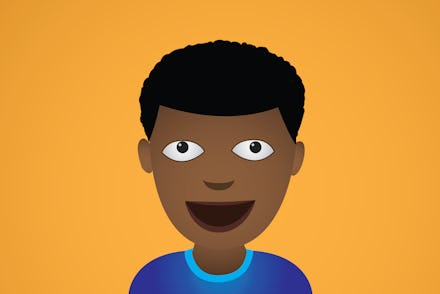How Emojis Would Look if They Weren't All White

“Are emoji racist?”
That’s the question Fast Company writer Christina Chaey asks in an August 2013 article. She’s referring to a pattern many users have noticed – namely that if you’re black, Latino or anything besides white, an Asian-looking boy or that brown guy with the turban, your range of expression is pretty narrow. There are literally two emojis that don’t appear to be Caucasian.
But according to Apple, that’s about to change – maybe. In an email response to a MTV Act inquiry, corporate communications VP Katie Cotton wrote:
“We agree with you. Our emoji characters are based on the Unicode standard, which is necessary for them to be displayed properly across many platforms. There needs to be more diversity in the emoji character set, and we have been working closely with the Unicode Consortium in an effort to update the standard.”
To tease your imagination, here’s how a more multicultural pair of emojis might look:
Image Credit: Tri Branch, PolicyMic
But will it actually happen? Cotton’s language is intentionally vague, and no timeline has been set. But whiteness in emoji-land has been subject to some high-profile criticism of late: Roots drummer ?uestlove and Smart Guy star Tahj Mowry (yes, I still think he’s famous) have both tweeted about the issue. Petitions have been signed. Even Miley Cyrus joined the fight, inching toward redemption for that one year when she just wouldn’t go away:
Yet the issue runs deeper than popular backlash. A quick look at the Unicode Consortium’s website shows the incredible range of languages and symbols they already employ, from Cherokee and Egyptian hieroglyphs to Gurmukhi, Ogham and Tifinagh (look it up). So why is their emoticon selection so limited?
It’s hard to say, but as ArsTechnica reports, the process of diversifying is a shit show. You have to start by making sure your proposed characters aren’t already in the system, on track to be in the system or haven’t already been rejected (I’m talking to you, Klingon Script). Then you have to fill out a form explaining why your characters are important enough to be included, and submit it for approval. If you’re unconvincing, sucks to be you – this process can take years.
So why doesn’t Apple just customize its own emojis? The benefit of using Unicode is that it’s standardized across many platforms. If Apple started making its own, the symbols wouldn’t show up properly in as many places, and folks would be stuck reading dumb little squares or boring stuff like “;)” and “:D”.
But this also means Apple has to play by Unicode’s rules. Whiteness has already been standardized and normalized in emoji-land, and the wait list for change is long and fraught with dense paperwork and judgmental approval boards. If anyone can expedite the process, one would assume it’s Apple. But we’ll have to wait and see.
As for the importance of emoji diversity, it’s the same argument as for broader representation anywhere. If a tool used by millions of people chooses such limited racial representation, it’s implicitly passing a value judgment on who’s normal and who’s important. Why do that when you can choose otherwise, especially with more and more studies showing the benefits of media diversity?
That's why this change is important. Hopefully the results materialize sooner rather than later.